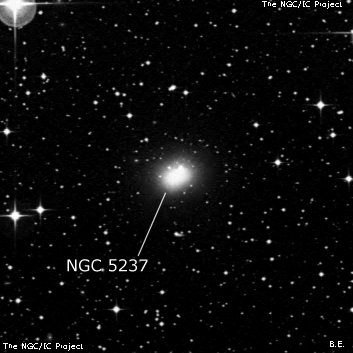
John Herschel discovered NGC 5237 = h3524 on 3 Jun 1834 and noted (first of 4 observations) "F; pL; oval; vgbM; 60" l; 50" br." A sketch was made by Joseph Turner in Jul 1876 using the Great Melbourne Telescope. MCG fails to label this galaxy as NGC 5237.
This galaxy, along with Fourcade-Figueroa galaxy = ESO 270-017, may have formed from a close interaction between Centaurus A and a spiral galaxy. A 1992 paper suggest it was ejected as a non-rotating shred of dusty, gas-rich disc material that appears as a blue irregular/starburst dwarf galaxy.
300/350mm - 14" (4/2/16 - Coonabarabran, 160x): moderately bright, fairly small, irregularly round (seems to change shape with averted vision). I saw no noticeable core but the galaxy seemed brightest at the west end with careful viewing. On the DSS, it appears I noticed either a very small companion that's merged on the northwest side or a blue, starburst region of the galaxy. NGC 5237 forms the southern vertex of an isosceles triangle with two bright stars; mag 7.4 HD 118337 7' NW and mag 7.0 HD 118483 7' NE! Member of the NGC 5128 (Cen A) group.
Notes by Steve Gottlieb